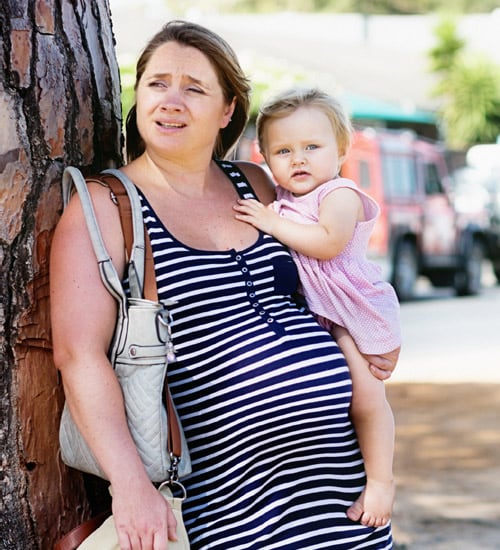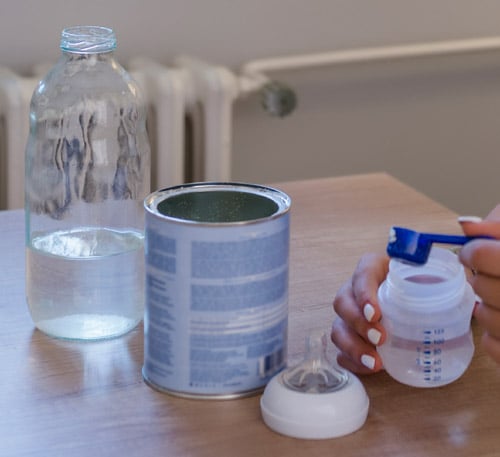Special Considerations for Emergencies
For families and emergency responders to learn about unique infant feeding considerations during evacuations, power outages, and emergencies that impact safe water.
What would happen if your family had to evacuate your home due to a hurricane, wildfire, or flood? What if there is a power outage? There are different types of emergencies that require special considerations for families with young children. Prepare now and learn what to consider for each emergency below.
Be prepared for an emergency by creating an emergency kit using CDC’s Emergency Kit Checklist for Kids and Families.
Evacuation considerations for families
If you have infant formula or expressed breast milk stored at home in a refrigerator or freezer, and you are leaving your home to travel to another location, carefully plan how you will transport it.
If your child is starting to eat solid foods, consider how you will transport food that needs to be refrigerated, and pack supplies that you will need to prepare the food.
You can take steps now to get ready, so you can safely transport the items you need to feed your child if an emergency happens.
Transporting expressed or stored breast milk and related supplies during an emergency:
Get Ready:
- Plan to continue breastfeeding through emergency seasons (e.g., wildfires, hurricanes).
- If you use a breast pump, learn to hand express your milk and practice in case you are without a pump during an emergency.
Keep these items on hand to transport breast milk in case you are ordered to evacuate:
- Cooler or insulated cooler bag.
- Ice packs.
- Disposable cups for feeding if you will not be able to clean bottles and nipples.
During an emergency:

- You can carry freshly expressed milk in a cooler or an insulated cooler bag with frozen ice packs for up to 24 hours. After arriving at your destination, use the milk right away, store it in the refrigerator, or freeze it.
- If you carry frozen milk in a cooler with frozen gel packs or ice, check your milk when you get to your destination. Upon arrival, if the milk has ice crystals, you can refreeze it.
- Keep in mind that previously frozen milk should be kept cold and used within 24 hours from the time it thaws completely. This will depend on the time spent traveling and the temperature of the cooler. If possible, check the milk after a few hours in the cooler to see if it has thawed.
- When you arrive at your destination, let the emergency responders know that you have expressed breast milk with you that needs to be refrigerated and stored safely.
- If you need to continue to express breast milk during or after evacuation, hand expression or a manual breast pump will allow you to continue to express milk without needing electricity. It is important that you clean your breast pump kit parts between uses with soap and a clean water source. Ask emergency responders if there is a clean area you can pump, a dedicated area to wash your pump parts, and a place to store your expressed breast milk. Be sure to label your milk for storage.
Transporting infant formula and related supplies during an emergency:
Get Ready:
Keep these items on hand to transport infant formula in case you are ordered to evacuate:
- Ready-to-feed (RTF) infant formula in single serving cans or bottles.
- Bottled water.
- Disposable cups for feeding if you are unable to clean bottles and nipples.
For formula-fed babies, it is safest to use ready-to-feed (RTF) infant formula because it does not need to be mixed with water and it comes in individual single-use containers. Unopened RTF infant formula does not need to be refrigerated. As babies grow, the amount of infant formula they drink in one day will change. Check your RTF infant formula supply in your emergency kit regularly to make sure it is not expired (or expiring soon) and that you have enough to feed your child for several days. Follow all storage directions and expiration dates on the RTF infant formula packaging.
During an emergency:
- If safe water is unavailable for cleaning bottles and nipples, you can use disposable cups to feed your child instead of bottles.
- If using RTF infant formula is not possible, it is best to use bottled water to prepare powdered or concentrated formula when your tap water is unsafe. If evacuating, bring bottled water with you to prepare powdered or concentrated infant formula as needed.
- Bring a copy of CDC’s How to Prepare and Store Powdered Infant Formula During an Emergency with you. Learn more about cup feeding and how to clean infant feeding supplies during an emergency.
Transporting solid foods and related supplies during an emergency
Get Ready:
Keep these items on hand to transport solid foods in case you are ordered to evacuate:
- Non-perishable, store bought baby food (enough for several days).
- A cooler or insulated cooler bag to hold foods that need to be refrigerated (e.g., fruits, vegetables, meats, dairy).
- Disposable plates, bowls, and utensils for feeding and preparing foods.
- Check your baby food supply in your emergency kit regularly to make sure it is not expired (or expiring soon) and that you have enough to feed your child for several days. As babies grow, they may eat more solid foods.
During an Emergency:

After arriving at your destination, ask where you can store and prepare your child’s foods, wash hands and feeding supplies, and feed your child.
Water safety considerations
During an emergency, water may become contaminated with germs, making it unsafe to use for mixing with powdered infant formula or cleaning infant feeding items and breast pump kit parts. Bottles, nipples, sippy cups, and pacifiers can easily grow germs when they are not cleaned well which can make your baby sick.
Get Ready:
- Have bottled water ready in case you need to use it. When RTF infant formula is unavailable, bottled water can be used to mix with powdered infant formula. In emergency situations bottled water is the safest choice for drinking and all other uses.
- Have disposable cups, plates, bowls, and utensils ready to feed your children safely.
During an emergency:
- Make sure you’re using safe water (either bottled water or tap water if local authorities say it’s safe) for preparing powdered infant formula.
- CDC has information on how to prepare and store powdered infant formula safely during an emergency.
- Use safe water to clean all infant feeding items.
- CDC has information on how to clean infant feeding items safely during and emergency. If safe water is not available for cleaning, use disposable infant feeding items including cups for cup feeding.
- If bottled water is not available, boil water for 1 minute (3 minutes at higher altitudes, above 6,500 feet) and let it cool before mixing with powdered formula. If you do not have access to bottled or boiled water, use disinfected water. Boiled or disinfected water is safe to mix with powdered infant formula. It is also safe to use for cleaning infant feeding items like bottles and nipples and breast pump kit parts. Learn more with CDC’s handout on making water safe during an emergency. [PDF-775KB] (Also available in Spanish [PDF-701KB]).
- Store boiled or disinfected water in clean sanitized containers with tight covers. This water can then be used to mix powdered infant formula and clean infant feeding items during the emergency.
- When you do not have safe water or cleaning supplies to clean bottles and nipples, feed your baby with disposable cups that can be used once and then thrown away. This will protect your baby from germs that can grow in bottles and nipples.
- Bottle nipples, pacifiers, and other hard to clean items that touch flood water should be thrown away. They cannot be sanitized.
- Throw away all food that may have come in contact with floodwater or stormwater. When in doubt, throw it out.
- CDC has information on how to keep food safe after an emergency and flood.
Power outage considerations for families

Loss of electricity can create many challenges for families during an emergency. Be prepared to safely store and prepare breast milk, infant formula or solid foods for infants and young children when there is a power outage.
Get Ready:
- If your baby is fed any amount of infant formula, keep RTF infant formula in single-serving cans or bottles as part of your emergency supplies in case the water is unsafe for mixing with powdered infant formula. Store in a cool, dry place.
- If you receive warning that a power outage may happen, consider making or purchasing extra ice to have on hand to keep breast milk and other food items cold.
- Freeze containers of water and gel packs to help keep your food cold during a power outage.
- Make sure you have an inexpensive freestanding appliance thermometer to check the temperature in your refrigerator and freezer.
During an emergency:
- Freezers, if left closed and full during a power outage, will keep food safe for about 48 hours (about 24 hours if half full). When freezers are full, the other frozen items help keep the freezer colder longer. The refrigerator will keep food cold for about 4 hours if it is unopened. While the power is out, keep the freezer and refrigerator doors closed as much as possible.
- Your refrigerator or cooler should be 40°F or below, and your freezer should be 0°F or below. If your refrigerator/freezer thermostats do not show the temperatures, use inexpensive freestanding appliance thermometers. Even if your refrigerator/freezer do show the temperatures, appliance thermometers may be important if you lose power or have mechanical problems.
For breast milk:

- If you have any breast milk in the freezer, you can help keep the freezer cold by packing any empty spaces in the freezer with frozen containers of water or gel packs and keeping the freezer door shut.
- Your breast milk may still be safe once your power comes back on, but it depends on how long the power is out and how defrosted or warm the breast milk becomes.
- Once the power is back on, check the condition of your stored breast milk. Frozen breast milk that has started to thaw but still contains ice crystals can be refrozen. If your breast milk has completely thawed but still feels cold, put it in the refrigerator and use it within the next day or throw it away.
For infant formula:
- Once the power is back on, check the temperature of your refrigerator. Throw away any opened or prepared formula that was in the refrigerator if your power has been off for 4 hours or more, or if the refrigerator temperature is above 40°F.
For solid foods:
- Throw away all perishable foods in your refrigerator when the power has been off for 4 hours or more.
- Throw away all perishable foods in your freezer if they have thawed.
- You can safely refreeze or cook food from the freezer if the food still contains ice crystals and feels as cold as if refrigerated.
For more information on keeping food safe during a power outage, visit USDA’s Keep Your Food Safe During Emergencies: Power Outages, Floods & Fires.

